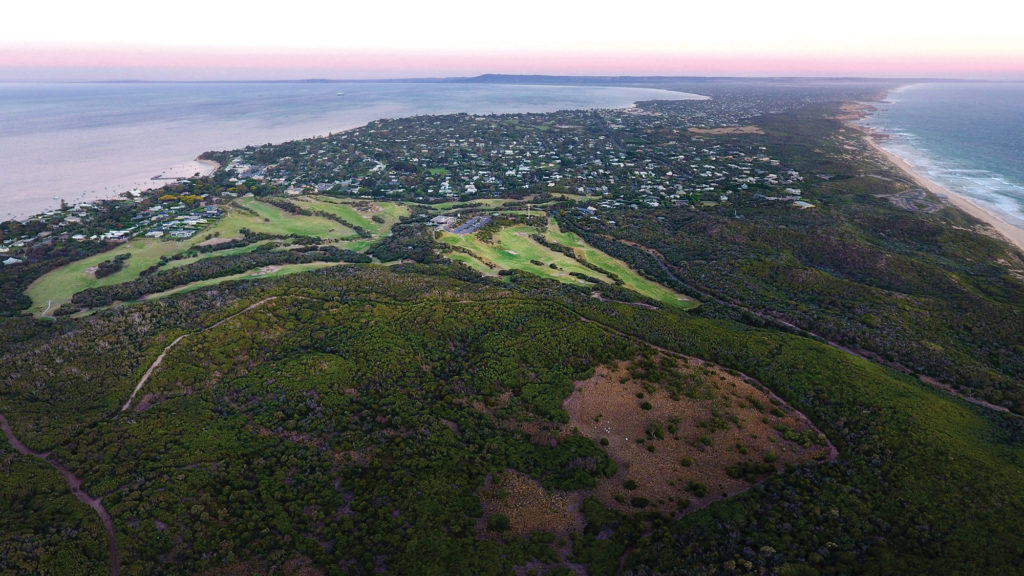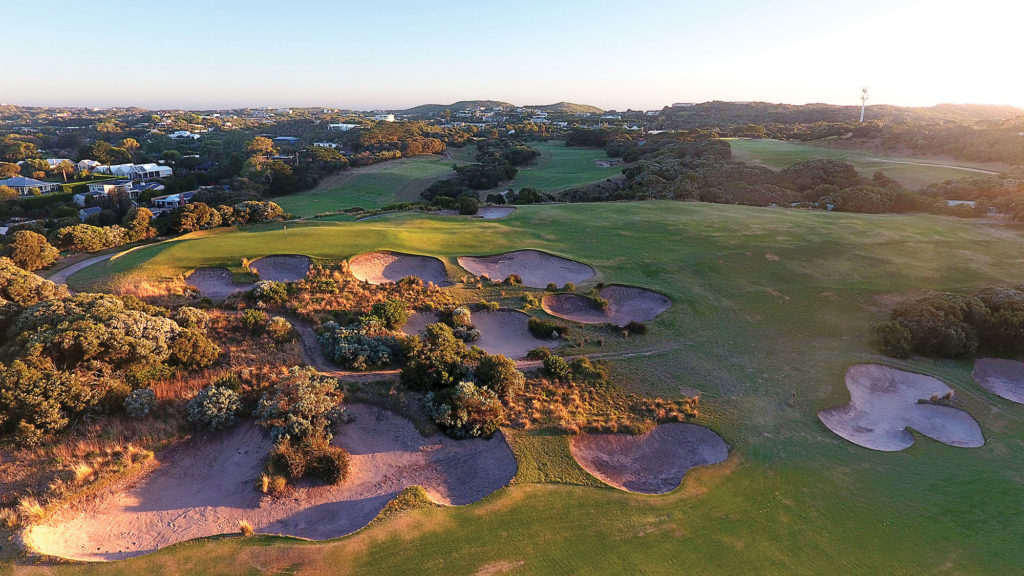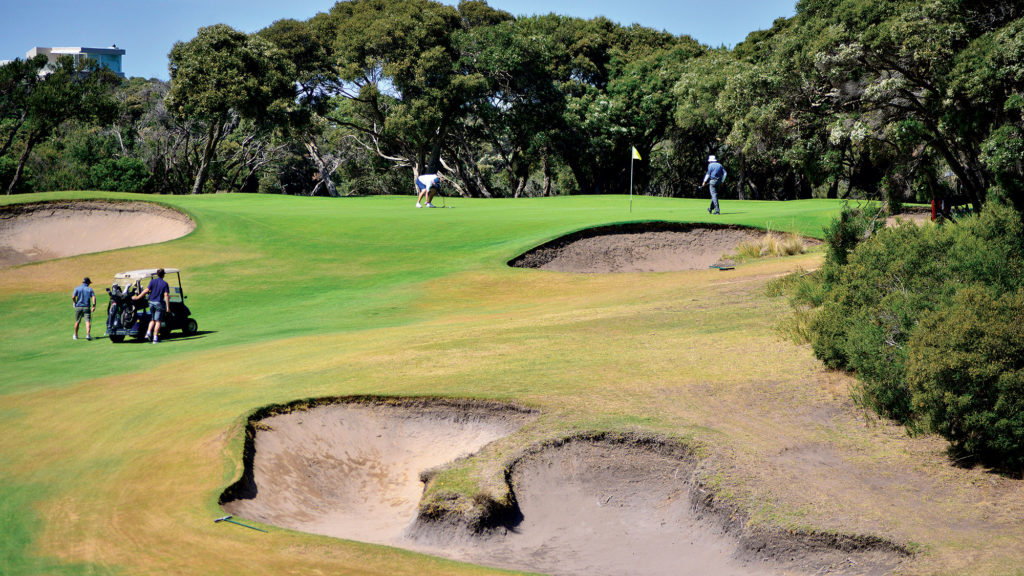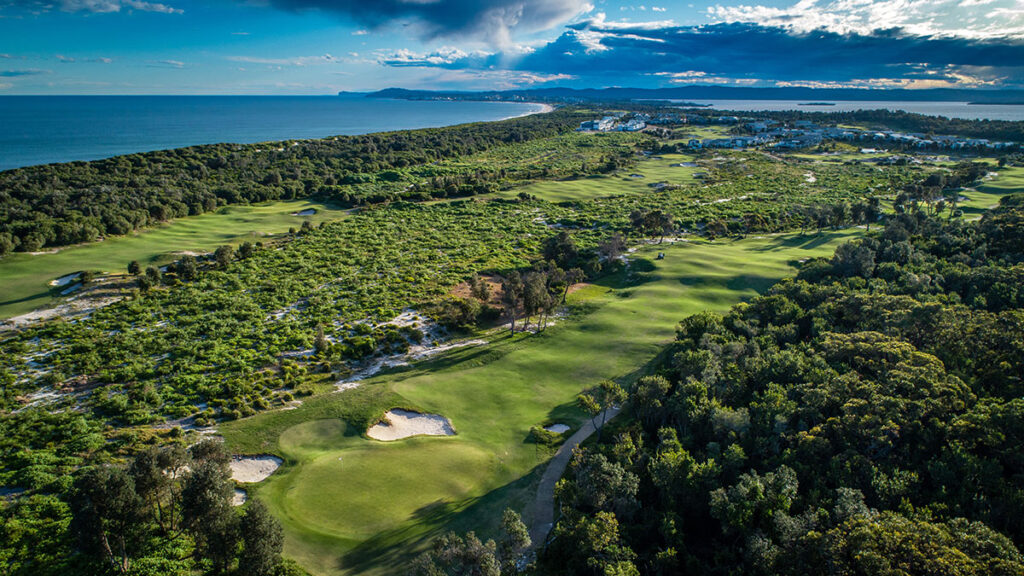Portsea’s big decision to sell land and build a new clubhouse is more than a decade in the past. Now the club is looking to strengthen its primary asset: the golf course.
Victoria’s gorgeous Mornington Peninsula offers a renowned stretch of world-class golf and one of its most alluring sits right at the far end of the scenic slice of land. Portsea Golf Club started life as a nine-hole layout in 1924 and over time blossomed into an 18-holer with a legion of followers who love the old-school charm it exudes.

The golf course is a classic case of good things coming in small packages. Located amid the region’s brawnier layouts, the 5,747-metre gem is a test that even modern technology cannot dilute. Firm and bouncy with rugged, natural bunkering, Portsea is as fun as it is fickle. It’s also a golf course that offers endless challenges. With Bass Strait on one side and Port Phillip Bay on the other, the capricious links-style layout rarely plays the same way twice.
Playing golf at Portsea is an 18-hole duel with the elements, the coastal breeze and exceptional natural landforms uniting to give golfers all they can handle. One minute is a downwind avenue beckoning a daring shot and an opportunity to score; the next sees a ball flying into a gnarled moonah tree or being swallowed by a craggy bunker or hungry sand dune.
“It is one of the most natural golf courses ever created,” enthuses Portsea’s vice-president David Bristow. “The course winds its way through, over and around rolling sand dunes with lush Santa Ana couch fairways bordered by native vegetation of old moonah trees and coastal grasses. Along with the coastal sea breezes, it creates a place where golfers are pitched against Mother Nature with every hole, every hazard and every shot being defined by nature’s infinite presence. It is a strategic golf course where a balance of length and precision iron play are required
to take on the challenge it offers.”

With such a seductive course, it’s little wonder golfers keep returning. Sixteen years ago, however, Portsea was feeling the pinch. In a bold move, the club elected to sell a parcel of its land to fund a new clubhouse that also includes a boutique hotel [see bottom of this article]. The plan paid off, the result not only improving its offerings and ensuring a sustainable financial future but also guaranteeing Portsea’s place in the excellent but competitive peninsula golf scene.
The golf course – now ranked 49th in Australia – required only two minor changes as a direct result of the land sale and construction of the current clubhouse. What was previously the first tee (and today is the ninth) had to be realigned to the left of its previous position and now asks for a drive that’s shaped right-to-left to use the camber of the canted fairway. The other alteration was a shortening of the former sixth hole (now the first) from a short par 5 to a par 4 of 308 metres to make way for the new clubhouse and carpark. At the same time Portsea’s holes began to be played in a different order, although it’s arguably a better routing, placing the most strategic holes at more appropriate points in the round.
Today, the club is latching onto the popular design trend of adding a spare hole. However, in this case it’s the return of a hole rather than a brand new one. What was once the old 15th hole, which under the current routing falls after the par-5 11th, is soon to be revived by course architects Ogilvy Cocking Mead (OCM) to become the club’s 19th for use when required. The old hole dropped out of the rotation when a new one-shotter was added in the north-eastern corner of the property in 2013 and now remains as the 13th hole. Reinstating the old par 3 will give the club flexibility when it comes to maintenance and have direct and positive impact on playing conditions.

Additionally, all the bunkers are set to undergo refurbishment works in the next six months that will improve playability and access into and out of each one in a project that is long overdue.
“It’s been about 65 years since any sort of material work was done on renovating the bunkers,” says Adam Hosie, Portsea’s general manager. “We’re really excited to have OCM guiding us through that project.”
Less glamorous but equally important is the club’s course maintenance equipment replacement program, which has seen the board commit to an $800,000 spend to upgrade the maintenance fleet. Portsea has several more course-improvement projects in mind for the next two to three years, all of which will enhance what is already a dynamic and enjoyable playing experience.

THE PLACE TO BE
The layout as it stands presents a wondrous mix of short and long. There are brilliant short par 4s, most notably at the ever-strategic 10th and 15th holes, mixed with several strong two-shotters. The 395-metre fourth hole quite rightly takes the No.1 stroke index, but equally strong are the lengthy par 4s at the 14th, 17th and 18th. The first of the trio tumbles downhill to a fantastic green complex nestled into a hillside below the eighth and 10th tees, while the two closers flow back and forth across a strip of the course that yielded a pair of the best and sternest holes.
The three par 5s showcase much of what the Portsea course is about. None touches the 500-metre mark (the third is a mere 436 metres), yet the twisting fairways call for accuracy and the small greens ask for perfection to approach and hold.

Not to be underestimated is the quartet of short holes, which possess diverse characteristics. The second hole occupies a secluded shelf within the land and plays to a green set in a small dell; the seventh moves downhill but the green offers little in the way of a bail-out. Heading for home, the 13th needs a precisely shaped and flighted iron shot to find any right-side flag in particular, while the 16th sees a green benched into a bank that can save any shot leaking right or punish one straying too far left.
The 24 hotel rooms that occupy a floor of the clubhouse, combined with the food and beverage offerings and top-class golf course, offer ample reason to remain on the property during a stay. The club is set to release some appealing stay-and-play packages, but while staying put is an attractive proposition, it makes little with so much else at your doorstep – and the club knows it.
“We get a lot of people who come here and might play golf for a day,” Hosie says. “They may take a second day off, and then they’ll have a second round on day three. And that second day is spent exploring the Portsea headland and national park, having lunch at the Portsea pub – all those iconic locations, which there’s plenty to see and do there to keep someone entertained from a non-golf perspective. People who have visited for three and four-day stays have often commented on how much there is beyond the golf experience, to see and do in the local Portsea and Sorrento area.”

THE DETAILS
Portsea Golf Club
Where: London Bridge Rd, Portsea VIC 3944
Phone: (03) 5981 6155
Web: portseagolf.com.au

THE GAMBLE THAT PAID OFF
The debate will rage on at many golf clubs for generations to come, and each club finds itself in unique circumstances at the time, but if the question were posed about how many clubs have truly benefitted from selling off a portion of land, it would be a short list. Portsea Golf Club would take a spot, though, thanks to some astute foresight 16 years ago.
In 2006, prestigious Portsea found itself with a decision that confronts many clubs in a tricky golf economy. The brilliant golf course was a wonderful natural asset, yet it was not enough to ensure the club’s long-term financial sustainability on its own. So with space to spare, the club sold 21 lots of land to fund a new $12 million clubhouse, restaurant and modern accommodation as a fully integrated entity. It’s not your average clubhouse, though, as this grand structure (which opened in 2013) includes 24 rooms impressive enough to attract the attention of Accor and become branded under the Mercure name.
The land sold covered the area behind what was the ninth green (it is now the fourth) and extended to include the space occupied by the original clubhouse. The sale of that land funded the construction of the new clubhouse, which – importantly within Portsea’s business model – included an additional revenue stream in the form of the 4½-star accommodation.
The building’s position takes full advantage of its lofty location. Panoramic views make 13 of the 18 holes visible from either inside the clubhouse or from the surrounding terrace, as well as across to Port Phillip Bay – all views not previously seen as this part of the site was formerly covered in scrub. The clubhouse layout is entirely functional and separates the members’ lounge from the large but compartmentalised function rooms. The hotel reception forms one end of the main floor with the pro shop, bar and lounge at the other. Downstairs, the king rooms and suites feature a king-sized bed, large LCD television with pay-per-view movies, Wi-Fi access, a work desk and a balcony with views of the golf course. The king twin rooms are identical other than having two single beds.
A significant aspect of the new iteration is its enviable location. The former clubhouse was accessed from the northern side of the course, off the main road that leads into Portsea town. The site selected for the new clubhouse was atop the highest point of the land, which happened to be near the middle of the course. The club is now accessed from the southern side via an entrance road that cuts through the course between the old second green and third tee (now the 15th and 16th holes).
No other member-based golf club in Australia has gambled on a hotel like Portsea did, yet the club trusted its plan and won with a bold yet considered move more than a decade ago that yielded a high-quality, multi-dimensional facility. Today it’s not just the club’s members but golfers across the country who are reaping the benefits.




